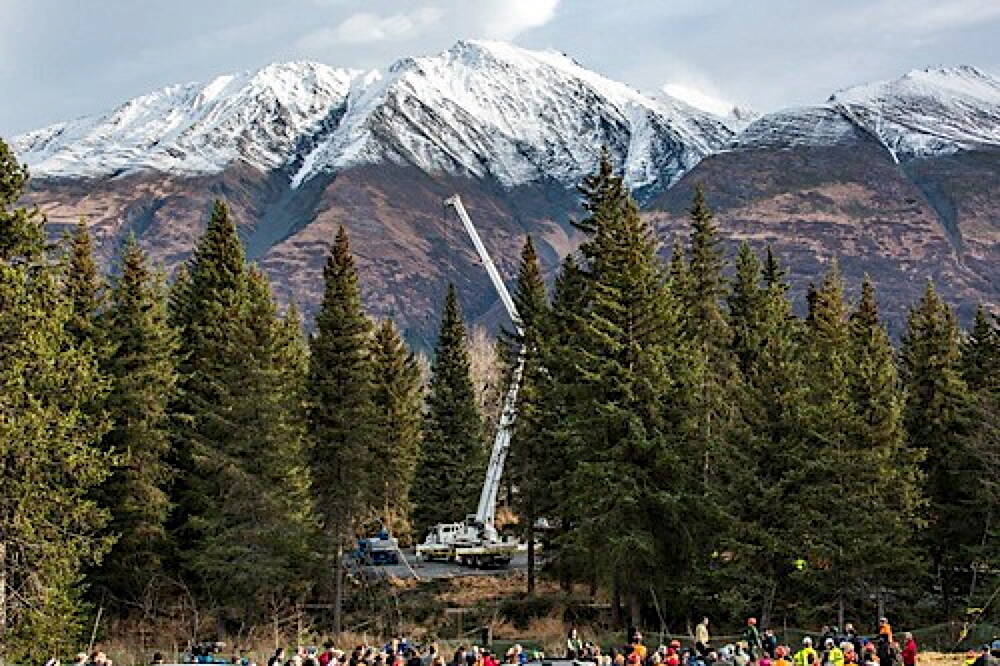A yet-unknown tree from the Tongass National Forest is slated to make a celebrity-worthy journey across the country this fall before being lit up as the 2024 U.S. Capitol Christmas Tree, only the second tree from Alaska to be the official tree displayed on the Capitol’s West Lawn.
In a process resembling presidential campaigns of the past, about eight to 12 candidate trees throughout the Tongass will be evaluated by regional U.S. Forest Service personnel, said Brandon Raile, a Forest Service spokesperson, in an interview last Wednesday, March 27. Once a nominee is selected by the Architect of the Capitol after on-site visits, the tree will make a “whistlestop tour” with a multitude of stops on the way to Washington, D.C.
“There are very specific criteria for the trees,” he said. “We’re looking for 65- to 80-foot-tall trees that have that good, classic-quality Christmas tree shape. And in an area that is as accessible as possible. We don’t want to be cutting roads back to get to these trees, so we’re looking for things that we can fairly easily get to.”
The tree is tentatively scheduled for arrival in D.C. on Nov. 22, so the planning for selection and transport is essentially a counting-back process, Raile said. He said the Architect of the Capitol is expected to visit in July to select the tree and the cross-country journey once it is shipped to the Lower 48 is expected to last about two weeks.
The only other Capitol tree from Alaska came from the Chugach National Forest in 2015. Since there is a rotation among Forest Service regions for the tree, the Tongass was chosen when Alaska’s turn came up this year as the state’s only other national forest, Raile said.
A Forest Service press release last Wednesday announcing the Tongass selection quoted top Alaska politicians, among others.
“I am excited to announce that Alaska’s Tongass National Forest has been chosen to provide this year’s Capitol Christmas Tree to grace the West Lawn,” U.S. Lisa Murkowski said in a prepared statement. “The Tongass is a special place for so many Alaskans who call it home – a place rich with resources and Native cultural history. This holiday season, I can’t wait to share some of the amazing aspects of the region and our state with the Capitol and the entire nation as we welcome The People’s Tree.”
Gov. Mike Dunleavy, in a statement, declared “it’s an honor to have the 2024 U.S. Capitol tree come from Alaska. With over 22 million acres of pristine wilderness, Alaska’s forests not only symbolize the grandeur of our nation but also embody the spirit of resilience and unity. As we prepare to share a piece of Alaska with the nation, I want to acknowledge Alaska’s National Forests team for their tireless work. Congratulations to everyone involved.”
The U.S. Capitol Christmas Tree — known as “The People’s Tree,” reflecting the nickname for the U.S. House of Representatives, “The People’s House” — has been selected each year since 1970 from a different National Forest, according to the Forest Service press release.
However, Alaska’s remoteness elevated the expense and logistics of providing a tree, along with other challenges that became evident when a roughly 75-foot Lutz spruce was cut down on Oct. 27, 2015, in the Chugach National Forest near Seward.
“We also have tree health considerations,” Raile said. “A tree harvested in the Chugach is used to much colder temperatures than it’s going to encounter pretty much anywhere else in the country. A tree from Southeast Alaska is going to be a little bit better off, but the tree health and what we learned in 2015 about taking care of it and transporting it that far, those definitely come into play.”
The history of the U.S. Capitol Tree, and upcoming selection and journey of the Tongass tree can be followed at www.uscapitolchristmastree.com.
Contact Mark Sabbatini at mark.sabbatini@juneauempire.com or 907-957-2306.


